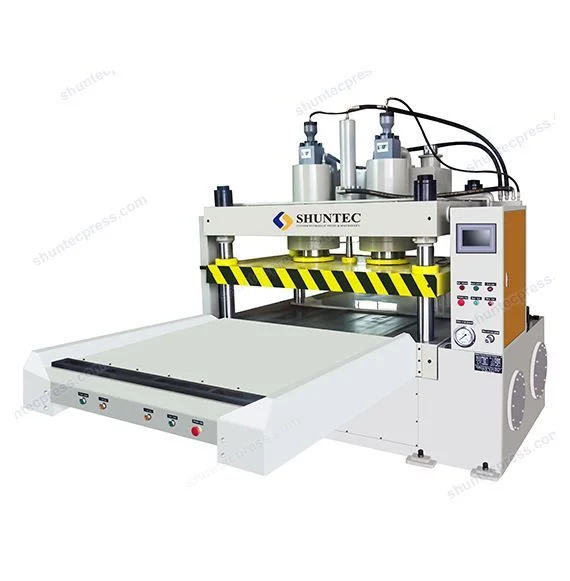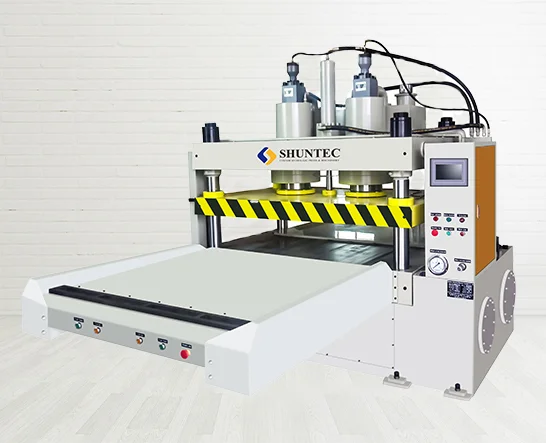1. Introduction to Die Cutting Press
A die cutting press is a versatile machine designed to cut, shape, or emboss materials into precise forms using a custom-made die. This technology plays a foundational role in manufacturing, enabling the production of uniform parts for industries ranging from packaging to automotive. By applying controlled force, the press ensures accuracy and consistency, making it indispensable for creating complex designs that manual methods cannot achieve.

The evolution of die cutting traces back to the 19th century, when manual lever-operated machines dominated. Over time, advancements like hydraulic systems revolutionized the process, offering higher pressure, faster operation, and adaptability to diverse materials. Today, modern hydraulic die cutting presses combine power with precision, supporting tasks from intricate paper crafting to cutting thick rubber or metal sheets.
In modern industries, die cutting presses streamline workflows while reducing waste. For example, packaging companies rely on them to mass-produce custom-shaped boxes, while automotive manufacturers use them to create precise gaskets and seals. Their ability to handle materials like plastics, textiles, and composites underscores their versatility. As automation and sustainability become priorities, these machines continue to evolve, balancing efficiency with eco-friendly practices—a theme we’ll explore further in this guide.
2. Types of Die Cutting Presses
Die cutting presses come in various designs, each tailored to specific materials, production scales, and precision needs. Understanding the differences ensures you select the right machine for your workflow.
Hydraulic Die Cutting Press
Hydraulic presses use fluid pressure to generate force, ideal for heavy-duty tasks. They excel in cutting thick materials like metal, rubber, or composites, offering adjustable pressure and consistent results. Common in automotive and industrial manufacturing, these machines handle high-volume jobs with minimal operator fatigue.
Mechanical Die Cutting Press
Mechanical models rely on flywheels and crankshafts for power. Faster than hydraulic presses, they suit lighter materials like paper, cardboard, or thin plastics. Their simplicity makes them cost-effective for small to medium batches, though they lack the pressure flexibility of hydraulic systems.
Key Differences: Hydraulic vs. Mechanical
- Force Control: Hydraulic presses adjust pressure dynamically; mechanical models operate at fixed settings.
- Speed: Mechanical presses cycle faster, while hydraulic ones prioritize power.
- Applications: Hydraulic for heavy materials; mechanical for lightweight, high-speed tasks.
Specialty Machines
- Rotary Die Cutting Press: Uses cylindrical dies for continuous cutting, perfect for labels, tapes, or flexible packaging.
- Pneumatic Press: Air-powered and compact, ideal for small workshops or prototyping.
- Hybrid Models: Combine hydraulic and mechanical features for versatility in mixed-material projects.
Choosing the right type hinges on your material thickness, production speed, and budget. For instance, hydraulic die cutting machines dominate heavy industries, while rotary models streamline high-speed packaging lines. In the next section, we’ll explore how these presses solve real-world challenges across sectors.
3. Key Applications Across Industries
Die cutting presses are vital tools across diverse sectors, delivering precision and efficiency in shaping materials. Here’s how they solve real-world challenges:
Packaging
- Custom Boxes & Inserts: Hydraulic die cutting machines create intricate shapes for luxury packaging or protective inserts.
- Labels & Stickers: Rotary presses produce high-volume, uniform labels for food, cosmetics, or logistics.
Automotive
- Gaskets & Seals: Hydraulic presses cut durable rubber or composite sheets for leak-proof components.
- Interior Parts: Foam, fabric, and plastic trim pieces are shaped consistently for seats and dashboards.
Textiles & Footwear
- Fabric Cutting: Die cut press machines ensure precise patterns for apparel, reducing fabric waste.
- Shoe Soles: Heavy-duty hydraulic systems handle thick rubber or EVA foam for durable soles.
Electronics
- Insulation Materials: Thin films and foams are cut to shield circuits or batteries.
- Component Housing: Plastic or metal casings for devices like smartphones or sensors.
Other Industries
- Medical Devices: Sterile packaging and silicone parts for implants.
- Aerospace: Lightweight composite materials for aircraft interiors.
From mass-producing cardboard boxes to crafting aerospace-grade components, die cutting presses adapt to industry-specific demands. Their versatility in handling materials like metal, rubber, and textiles makes them indispensable—whether for small batches or large-scale production. Next, we’ll explore the advantages that make these machines a smart investment.
4. Advantages of Using a Die Cutting Press
Die cutting presses offer transformative benefits for businesses seeking efficiency and precision. Here’s why they are a cornerstone of modern manufacturing:
Unmatched Precision & Consistency
Every cut or emboss matches the die’s design, eliminating human error. This is critical for industries like electronics, where components require micron-level accuracy.
High-Speed Production
Automated hydraulic die cutting machines process hundreds of units per hour, outpacing manual methods. Rotary models excel in continuous tasks, such as label cutting for packaging lines.
Material Versatility
- Paper & Cardboard: Ideal for custom packaging.
- Metals & Composites: Used in automotive or aerospace parts.
- Rubber & Foam: Perfect for seals, gaskets, or footwear.
Reduced Waste
Precise cutting minimizes material scrap, lowering costs and supporting sustainability goals. For example, textile manufacturers optimize fabric layouts to save up to 20% in waste.
Scalability
Whether prototyping with a pneumatic press or running 24/7 production on a hydraulic die cutting press, these machines adapt to small batches or mass volumes.
Cost Efficiency
Long-term savings offset initial investments. Reduced labor, faster turnaround, and minimal rework make die cut press machines a smart ROI for industries like medical device manufacturing.
From boosting productivity to enabling complex designs, die cutting presses empower businesses to stay competitive. Next, we’ll guide you through choosing the right machine for your needs.
5. How to Choose the Right Die Cutting Press
Selecting the ideal die cutting press requires balancing technical needs, budget, and long-term goals. Here’s a streamlined approach to decision-making:
Assess Your Material & Production Volume
- Material Type: Hydraulic die cutting machines handle thick metals or rubber, while mechanical presses suit paper or thin plastics.
- Volume: High-speed rotary or hydraulic models excel in mass production; pneumatic presses are cost-effective for prototypes or small batches.
Hydraulic vs. Mechanical: Key Considerations
- Hydraulic Presses: Best for heavy-duty tasks, adjustable pressure, and complex cuts. Ideal for automotive or industrial applications.
- Mechanical Presses: Faster cycle times, lower upfront costs. Perfect for lightweight materials like packaging or textiles.
Prioritize Essential Features
- Pressure Capacity: Ensure the machine matches your material’s thickness (e.g., 100+ tons for metal cutting).
- Automation: Look for programmable settings or CNC integration for repeatable, high-precision tasks.
- Safety: Guards, emergency stops, and compliance with industry standards (e.g., CE, OSHA).
Budget & ROI
Factor in long-term savings: hydraulic die cutting presses may cost more upfront but reduce labor and waste over time. Leasing or refurbished models can ease initial investments for startups.
By aligning these factors with your operational needs, you’ll find a die cut press machine that boosts productivity without overspending. Next, learn how to maintain your equipment for peak performance.
6. Maintenance Tips for Longevity
Proper maintenance ensures your die cutting press operates efficiently and lasts longer. Follow these practical steps to minimize downtime and repair costs:
Routine Inspections
- Hydraulic Systems: Check fluid levels, hoses, and seals weekly. Look for leaks or pressure drops.
- Dies & Blades: Inspect edges for wear or damage. Replace or sharpen them to maintain cut quality.
Lubrication Schedule
- Lubricate moving parts (e.g., guides, bearings) monthly with manufacturer-recommended oils.
- For hydraulic die cutting machines, replace hydraulic fluid annually to prevent contamination.
Cleaning Best Practices
- Remove debris and material residue from dies, cutting beds, and rollers after each shift.
- Use non-abrasive cleaners to avoid damaging sensitive components.
Address Common Issues Early
- Misalignment: Calibration tools to check die positioning regularly.
- Unusual Noises: Investigate immediately to prevent motor or gear damage.
- Overheating: Ensure cooling systems (fans, vents) are dust-free and functional.
Operator Training
Train staff to follow safety protocols and report abnormalities. Simple habits, like avoiding overloading the machine, prevent premature wear.
By prioritizing these steps, your die cut press machine will deliver consistent performance while extending its lifespan. Next, we’ll answer frequently asked questions to resolve lingering doubts.
7. FAQs
What’s the difference between a hydraulic and mechanical die cutting press?
Hydraulic presses use fluid pressure to generate force, offering adjustable power and suitability for heavy materials like metal or rubber. Mechanical presses rely on flywheels for faster, fixed-force cycles, ideal for lightweight tasks such as paper or plastic cutting.
Can a hydraulic die cutting machine handle thick metals?
Yes. Hydraulic systems excel in cutting thick metals, composites, or dense rubber due to their high-pressure capabilities (often 100+ tons). Ensure the machine’s pressure rating matches your material’s requirements.
How do I reduce waste when using a die cut press machine?
Optimize die layouts to maximize material usage. For example, nesting designs on fabric or cardboard sheets can minimize scrap. Regular die maintenance also ensures clean cuts, avoiding material errors.
What industries benefit most from die cutting presses?
Key sectors include packaging (custom boxes, labels), automotive (gaskets, seals), textiles (apparel patterns), and electronics (insulation films). Their versatility supports both niche and mass-production needs.
Are die cutting presses energy-efficient?
Modern hydraulic models often include energy-saving features like variable-speed pumps. Routine maintenance, such as cleaning filters and checking fluid levels, further optimizes efficiency.
What safety features should I prioritize?
Look for emergency stop buttons, protective guards, and compliance with safety standards (CE, OSHA). Proper operator training is equally critical to prevent accidents.
How long does a die cutting press typically last?
With proper maintenance—regular lubrication, timely part replacements, and avoiding overloads—a well-built machine can operate efficiently for 10–15 years or more.
8. Conclusion
Die cutting presses are more than just industrial tools—they are catalysts for precision, efficiency, and innovation across countless industries. From crafting intricate packaging designs to shaping critical automotive components, these machines bridge creativity with technical excellence. Hydraulic die cutting machines, in particular, stand out for their power and adaptability, while mechanical and specialty models cater to niche demands like high-speed label production or prototyping.
Choosing the right die cut press machine hinges on understanding your material requirements, production scale, and long-term goals. Regular maintenance and operator training further ensure that your investment delivers consistent returns over years of service. As industries increasingly prioritize automation and sustainability, modern die cutting technology continues to evolve, offering smarter, energy-efficient solutions.
Whether you’re a startup exploring small-batch production or an established manufacturer scaling operations, the right die cutting press can elevate your output quality while reducing costs. By applying the insights from this guide, you’re equipped to make informed decisions that align with your unique needs. The future of manufacturing is precise, and with the right tools, you’re ready to lead it.

